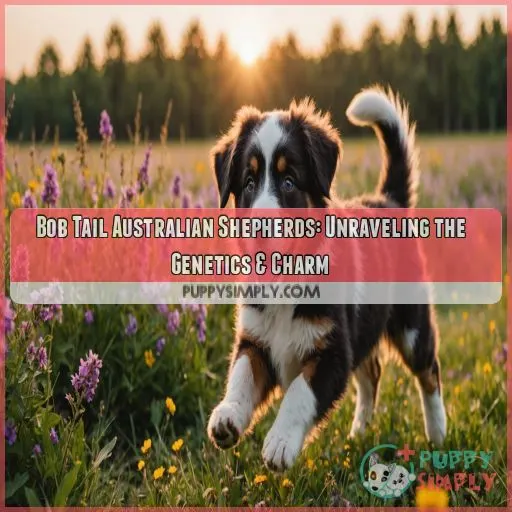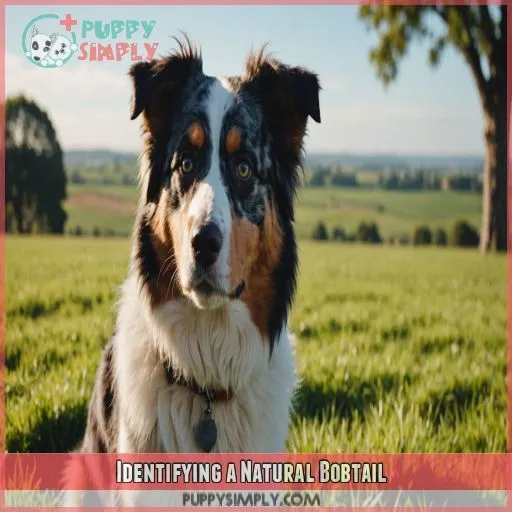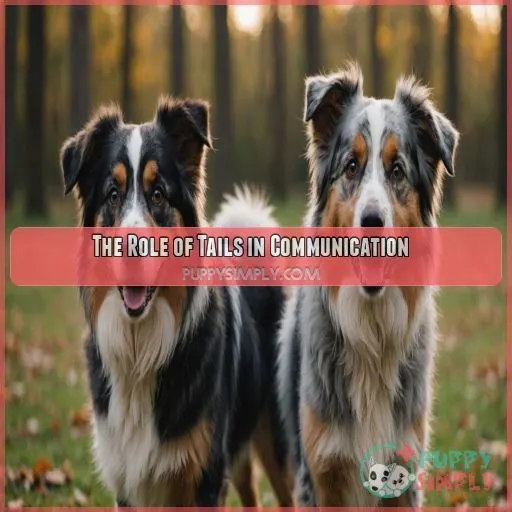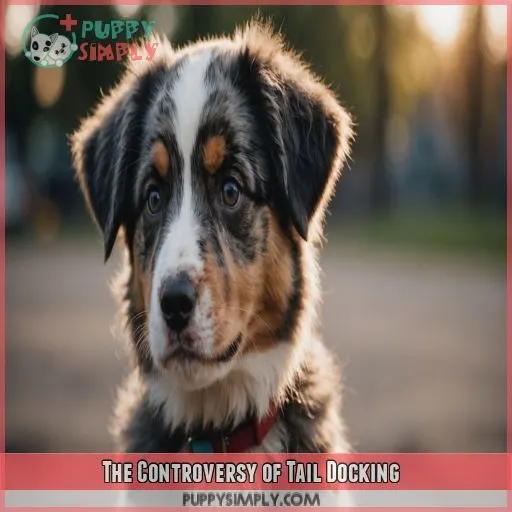This site is supported by our readers. We may earn a commission, at no cost to you, if you purchase through links.

What’s behind this unique charm? It all starts with the T locus, a dominant gene that determines whether your Aussie will have a bobtail.
Breeding practices also come into play, as ranchers once selectively bred Aussies with natural bobtails to reduce herding risks.
Ready to uncover more about the fascinating genetics and charm of these unforgettable dogs?
Table Of Contents
- Key Takeaways
- The Genetics of Bob Tails
- Natural Bobtails Vs. Docked Tails
- Identifying a Natural Bobtail
- The Role of Tails in Communication
- Tail Health and Care
- The Significance of Aussie Tails
- The Controversy of Tail Docking
- Embracing the Tail’s Tale
- Technology for Tail Care
- The Future of Bob Tail Australian Shepherds
- Frequently Asked Questions (FAQs)
- Do Australian Shepherds have bob tails?
- What is the difference between a docked tail and a bobbed tail?
- How to tell if a dog has a natural bobtail?
- Why do dogs have bob tails?
- Are bobtail Australian Shepherds more prone to back issues?
- Can bobtail Aussies still participate in herding activities?
- How do I care for my bobtail Aussies spinal health?
- Are there specific nutrition requirements for bobtail Aussies?
- Do bobtail Australian Shepherds have unique exercise needs ?
- Conclusion
Key Takeaways
- Those adorable Bobtail Australian Shepherds get their short tails from a genetic mutation that’s just a roll of the dice – about 20% are born with it, making them uniquely adorable! Responsible breeding practices are key to preserving the breed’s health and temperament.
- A natural bobtail is different from a docked tail, which is surgically shortened – think of it like the difference between a naturally short haircut and a trim. You can spot a natural bobtail by its stubby length or confirm it with a DNA test.
- A Bobtail Aussie’s tail may be short, but their herding instincts and energy remain intact, so they can still get their herd on and participate in herding activities. They just might have a different way of communicating, relying more on body posture and ear positioning.
- With their high energy and joint health needs, Bobtail Aussies require balanced, nutrient-rich foods and a comfy place to rest. Consider their spinal health and provide regular check-ups, gentle exercises, and plenty of playtime to keep them happy and healthy!
The Genetics of Bob Tails
You’re probably curious about what makes your Bob Tail Australian Shepherd‘s tail so unique – after all, it’s a defining feature of this charming breed. Let’s break down the genetics behind those adorable bob tails, exploring the T Locus and how it influences the length and type of tail your Aussie will have.
The T Locus and Its Role in Tail Length
You’re curious about the T Locus and its role in tail length.
Simply put, it’s a genetic spot that controls whether your Aussie has a bobtail or not.
With two versions (T and t), the T allele is dominant, while the t allele is recessive.
This means a single T allele can result in a bobtail, making DNA testing important for responsible breeding practices.
Genotypes and Phenotypes Explained
Let’s break down the genetics of bobtails.
You’ve got two alleles at the T locus: T (dominant) and t (recessive).
Your Aussie’s genotype (T/T, t/T, or t/t) determines their phenotype – a bobtail or normal tail.
Think of it like a recipe: mix and match alleles to get the desired trait.
Understanding genotypes and phenotypes is key to grasping bobtail genetics.
Inheritance Patterns and Breeding Implications
You’re about to learn about bobtail inheritance. It’s important to understand how this trait is passed down to make responsible breeding decisions. Here are the key takeaways:
- A dog with the t/T genotype will pass on the T allele to 50% of its offspring.
- Genetic testing is essential for identifying carriers of the T allele.
- Responsible breeding practices focus on the health and well-being of both parents and offspring.
- T locus testing helps breeders make informed decisions.
- Ethical breeding is key to preserving the breed’s integrity.
Natural Bobtails Vs. Docked Tails
So, you’re curious about the difference between natural bobtails and docked tails on Aussie dogs? Natural bobtails are a genetic trait, a quirk of Mother Nature, while docked tails are a result of human intervention, a snip here and a clip there.
What is a Natural Bobtail?
There’s a big difference between a natural bobtail and a docked tail. A natural bobtail is the result of genetics, specifically a mutation in the T-box transcription factor T gene. This gene mutation leads to a shortened tail, and it’s inherited. On the other hand, a docked tail is when a dog’s tail has been surgically shortened, usually for breed standards or cosmetic reasons.
| Type | Cause | Length |
|---|---|---|
| Natural Bobtail | Genetic Mutation | Varies |
| Docked Tail | Surgical Procedure | Shortened |
It’s important to know the difference, especially for breeders. Natural bobtails can be verified with a DNA test, ensuring ethical breeding practices and avoiding potential health risks.
Why Do Dogs Have Bob Tails?
You might be wondering why some dogs sport those adorable bob tails while others have longer, more flowing tails. Well, it’s all about genetics and breed standards, folks!
- Natural Bobtails: Occur from a mutation in the T-box transcription factor T gene, resulting in a short tail. It’s autosomal dominant, affecting both male and female dogs.
- Docked Tails: Are a result of human intervention, where a dog’s tail is surgically shortened for breed conformation and identification.
- History: Breeds like the Old English Sheepdog and Brittany Spaniel were originally bred with longer tails but have been crossed with bobtail dogs, introducing the mutation.
- Health and Communication: While bob tails don’t affect a dog’s health, they do impact how they communicate. Body posture and ear positioning become even more important visual cues.
Identifying a Natural Bobtail
Wondering how to spot a natural bobtail? It’s all in the genes, specifically the T-box transcription factor T gene. This unique trait is an eye-catching feature of the Aussie, and understanding the genetics behind it’s key to responsible breeding and the health of these playful pups.
Testing for the T Locus
Testing for the T locus is a must for responsible breeders.
It helps identify dogs with the recessive t/t genotype.
This is important for ethical breeding practices.
The test helps guarantee the health of future pups by preventing the lethal T/T combo.
It also reveals carriers, even if they sport full tails.
At $55, this test is a no-brainer for bobtail breed enthusiasts.
It helps make informed decisions and protect the health of their pups.
Understanding the Results of a DNA Test
- Verification: The test will confirm if your Aussie has the natural bobtail trait.
- Breeding Insights: Results help breeders choose pairs to avoid lethal deformities and reduced litter sizes.
- Carrier Status: Identify carriers of the bobtail gene, even if they don’t show the trait.
- Ethical Implications: Testing helps breeders make responsible choices, reducing risks associated with the lethal genotype.
The Role of Tails in Communication
You know Aussies are talkers, but did you know their tails do the talking, too? From wags of happiness to subtle signs of stress, decoding Aussie tail language is key to understanding their moods and emotions.
Tail Talk in Action: Understanding Aussie Tail Expressions
Aussie tail talk is a whole language of its own, with tail wags, positions, and movements all sending signals.
These bobtail Aussies sure know how to express themselves!
Their tail language is like a window into their emotions, and it’s a fascinating part of their unique charm.
Whether it’s a playful wag, a confident high-held tail, or a subtle shift, these dogs are communicating loud and clear.
A Vibrant Display: Aussie Tail Wagging
Your Aussie’s tail is like a built-in mood ring, offering a glimpse into their emotions.
A happy Aussie might do the "Aussie circle," a full-body wiggle with a thumping tail.
Tail language is a giveaway: a high-held tail shows alertness, while a tucked tail signals fear.
Wagging speed and tail position speak volumes about your dog’s mood, so keep an eye on those tail signals!
The Emotional Tale of Tails
Tails are emotional barometers, and Aussie tails are no exception. They convey feelings and intentions through:
- Tail Wagging: A happy, relaxed Aussie will likely have a gently wagging tail, showing excitement and contentment.
- Tail Language: Whether it’s a full tail or a natural bob tail, the position and movement communicate emotions, from confidence to fear.
- Tail Injuries: A tucked tail can indicate pain or anxiety, so it’s important to keep an eye on tail health and address any injuries or discomfort.
Tail Health and Care
Your Aussie’s tail is more than just a cute accessory – it needs care and attention to stay healthy. We’ll cover tips to keep their tail in tip-top shape, from preventing injuries to spotting potential issues.
Tail Care Tips
Keep their tail hygiene in check. Give it a good scrub in the bath to prevent grime buildup.
Tail injuries are a common concern for Australian Shepherds. Their tails are like antennas, so watch for scratches or cuts.
Be mindful of happy tail syndrome, where they whack their tails on things and can bruise or break it.
Preventing Tail Injuries and Infections
Now that you’ve got the basics of tail care down, let’s talk about preventing those pesky tail injuries and infections! After all, a healthy tail is a happy tail. Here are three tips to keep your Aussie’s tail in top shape:
- Watch for signs of infection: Redness, swelling, or discharge can indicate a problem.
- Keep it clean: Regularly wash and dry your Aussie’s tail to prevent dirt buildup.
- Protect it from harm: Be mindful of your Aussie’s surroundings to avoid accidental injuries.
The Significance of Aussie Tails
You’re probably wondering why Aussie tails are such a big deal – after all, they’re just a furry extension at the back of your dog, right? But the truth is, your Australian Shepherd’s tail plays a huge role in their communication, balance, and even their emotional well-being, making it a key part of their overall health and happiness.
More Than Just a ‘Rear’ Sight
Your Aussie’s tail is more than just a cute feature – it’s a key part of their expression and health. A wagging tail can indicate excitement or friendliness, while a tucked tail may signal fear or anxiety. By understanding tail language, you can better connect with your Aussie and keep their tail healthy and happy.
The Importance of Tails in Canine Communication
The Significance of Aussie Tails
Aussies are known for their expressive tails, and understanding tail language is key to interpreting their mood and intentions:
- A high, upright tail signals confidence and alertness.
- A relaxed, low-hanging tail indicates a calm, laid-back mood.
- A tail tucked under suggests fear or anxiety.
- Stiff, straight tails often indicate aggression or defensive behavior.
Like a personal billboard, an Aussie’s tail advertises their emotions to the world.
Keeping Tails Wagging: the Key to Happy Aussies
You know that a wagging Aussie tail is more than just a pretty sight – it’s a key to their happiness!
As a responsible owner, you want to keep that tail wagging.
Focus on providing regular exercise, mental stimulation, and positive reinforcement training.
The Controversy of Tail Docking
You’re probably wondering why some Australian Shepherds have naturally short tails, while others have had their tails docked – and what’s the big deal about it anyway? Let’s explore the controversy surrounding tail docking and what it means for your Aussie’s health, happiness, and overall well-being.
Tail Docking: a Controversial Practice
Tail docking is a hot-button issue, stirring up emotions and ethical dilemmas.
It’s an age-old practice rooted in aesthetics and breed standards, but it’s not without controversy.
The procedure involves cutting a puppy’s tail, often for cosmetic reasons, which raises concerns about animal welfare and pain.
Some countries have implemented legislation banning or restricting this practice, recognizing the tail’s vital role in a dog’s communication and well-being.
USASA: Stance on the Tail
When it comes to the tail docking debate, it’s good to know where the USASA stands. They’re all about ethical breeding and keeping tails healthy. Here’s the lowdown:
- The USASA encourages breeders to stick with natural, undocked tails.
- They push for Aussie breed standards education and responsible breeding practices.
- This way, they aim to keep the breed strong and healthy.
ASCA: Stance on the Tail
ASCA, the Australian Shepherd Club of America, takes a firm stance against tail docking. They believe it’s an unnecessary and painful procedure that goes against ethical breeding and responsible ownership. ASCA’s breed standard doesn’t require a docked tail, embracing the natural bobtail as a unique trait. For more insights, check out dog breed info books, mags, vids, articles, or docs.
Embracing the Tail’s Tale
You’re probably wondering what makes Bob Tail Australian Shepherds so special – is it their adorable stubby tails or their charming personalities? As you get to know these unique dogs, you’ll discover that it’s a combination of both, making them a true standout in the canine crowd.
Love in All Sizes and Shapes
Love in All Sizes and Shapes (Embracing the Tail’s Tale)
Aussie lovers embrace the unique shape and size of their dogs’ tails, celebrating the bobtail as a charming feature.
Some notable characteristics of this feature include:
- Variety: Bobtails come in a range of lengths, from nearly full-sized to almost non-existent.
- Dominant Gene: The bobtail gene is dominant, so it only takes one copy for a dog to have a bobbed tail.
- Lethal Gene: Unfortunately, two copies of the gene are lethal, which is why responsible breeding practices are super important.
Embracing the natural bobtail is all about celebrating the diversity and uniqueness of Aussies.
The Unique Character of Bob Tail Australian Shepherds
Bobtail Aussies are loyal, intelligent, and gentle.
They are active, working dogs that thrive with a job to do because of their herding instincts.
While they’re quick to learn, their independent thinking requires patience during training.
Early socialization is key to ensuring these dogs grow into well-adjusted, people-loving pooches.
With their unique blend of smarts and spirit, Bobtail Aussies are a breed that captures the hearts of dog enthusiasts everywhere.
When Tails Resemble Ears
You might’ve noticed some Aussies sport tails that curl upward, resembling a cute little piglet’s tail or, yep, even ears!
This unique feature adds to the overall charm and cuteness of bob-tailed Aussies.
It’s like they’ve a built-in, perky accessory that always looks ready for a fun adventure.
These curly-tailed Aussies are sure to bring a smile to your face and brighten up your day with their one-of-a-kind look.
Technology for Tail Care
You’re probably wondering how technology can help with tail care for your bob tail Australian Shepherd – well, the answer lies in innovative gadgets like the Fi Dog Collar, designed to monitor your Aussie’s daily activities and help keep their tail healthy and happy. With features like exercise monitoring, you can keep your furry friend’s tail wagging while also keeping an eye on their overall well-being .
Fi Dog Collar: Tailoring Tech to Your Aussie’s Needs
You want the best for your Aussie, and that includes tailoring tech to their needs! The Fi Dog Collar is a game-changer for activity tracking, GPS tracking, and tail health. Here are four ways it can boost your Aussie’s fitness and safety:
- Track activity levels and set fitness goals.
- Monitor escape attempts with GPS tracking.
- Detect health issues with activity tracking.
- Get alerts for potential health concerns.
Exercise Monitoring With Fi
With Fi, you’ll get tail-wagging data to inform your Aussie’s exercise routine. This GPS tracker monitors activity levels, helping you set realistic exercise goals. Plus, it’s a game-changer for dog management and animal welfare. Imagine having Las Rocosa Australian Shepherds-level expertise in your pocket! By using Fi, you’re investing in your Aussie’s health and happiness.
The Future of Bob Tail Australian Shepherds
You’re now a part of the Bob Tail Australian Shepherd fan club, and it’s time to think about the future of this beloved breed! As you consider bringing a bob-tailed Aussie into your life, remember that responsible breeding practices, preserving the breed’s health and temperament, and thorough research are key to ensuring these charming dogs thrive for generations to come.
Responsible Breeding Practices
As you consider bringing home a Bob Tail Australian Shepherd, you’re supporting responsible breeding practices. Here are four signs of an ethical breeder:
- They prioritize health screening for genetic disorders
- Genetic diversity is maintained to prevent linebreeding risks
- Transparency about breeding goals and methods
- A focus on the dog’s welfare over profit
Preserving the Breed’s Health and Temperament
When you’re thinking about Bobtail Australian Shepherds, remember that keeping the breed healthy and happy is really important.
It’s a breeder’s job to make sure there’s a mix of genes, do thorough health checks, and teach others about ethical breeding.
The Importance of Research and Preparation
Bringing home a bob tail Australian Shepherd is a big decision, so it’s important to do your research. You need to find out what makes this breed special, track down breeders who care about their dogs, and understand the responsibilities of pet ownership. Your future best friend is relying on you to make smart choices.
Here are four things to keep in mind:
- Know the breed standards: Learn about the typical traits, behaviors, and needs of bob tail Australian Shepherds.
- Find a reputable breeder: Seek out breeders who prioritize the health, temperament, and well-being of their dogs.
- Understand health concerns: Become familiar with potential health issues and how to address them.
- Commit to lifelong care: Make sure you’re ready to provide a loving, caring, and attentive home for your new dog.
Frequently Asked Questions (FAQs)
Do Australian Shepherds have bob tails?
Coincidentally, you’re wondering about Aussie Shepherds and their tails – yep, some do have bobbed tails! Due to a genetic mutation, about 20% are born with a natural bobtail, making them uniquely adorable.
What is the difference between a docked tail and a bobbed tail?
Hey there, curious pet owner! So, you’re wondering what’s the difference between a docked tail and a bobbed tail? Well, a docked tail is surgically shortened, while a bobbed tail is a natural, genetic trait .
How to tell if a dog has a natural bobtail?
The irony – a "short" question about short tails! To tell if a dog has a natural bobtail, look for a stubby tail that’s shorter than usual, or get a DNA test to confirm the presence of the T allele.
Why do dogs have bob tails?
You’re curious about those adorable bob tails, aren’t you? Well, it’s due to a natural genetic mutation that affects the T-box transcription factor T gene, causing a shortened tail in some breeds .
Are bobtail Australian Shepherds more prone to back issues?
You’re likely wondering if those adorable bobtailed Aussie Shepherds are more prone to back issues – think of their tail as a balancing pole; some studies suggest a link, but more research is needed to confirm .
Can bobtail Aussies still participate in herding activities?
Hey there, herding enthusiast! Can bobtail Aussies still get their herd on? Absolutely! While their tail may be shorter, their herding instincts and energy remain intact. Get ready to channel that energy into some fun herding activities!
How do I care for my bobtail Aussies spinal health?
Don’t let a shortened tail fool you – spinal health is just as important! Make sure your Aussie is comfortable with regular check-ups, gentle exercises, and a comfy place to rest. A healthy spine means a happy, wagging life (even sans tail)!
Are there specific nutrition requirements for bobtail Aussies?
You want to fuel your furry friend‘s adventures! As a bobtail Aussie owner, focus on balanced, nutrient-rich foods, considering their high energy and joint health needs. Consult your vet for personalized nutrition advice .
Do bobtail Australian Shepherds have unique exercise needs ?
As you lace up your running shoes, remember, your bobtail buddy needs exercise that’s the ‘paw-fect’ blend of physical and mental stimulation. Aim for daily doses of play, training, and adventure to keep them happy and healthy!
Conclusion
Did you know that one in five Bobtail Australian Shepherds are born with a naturally short tail?
The T locus plays a significant role in determining this unique charm.
With responsible breeding practices and a deeper understanding of genetics, you can help preserve the health and temperament of these lovable dogs.
















